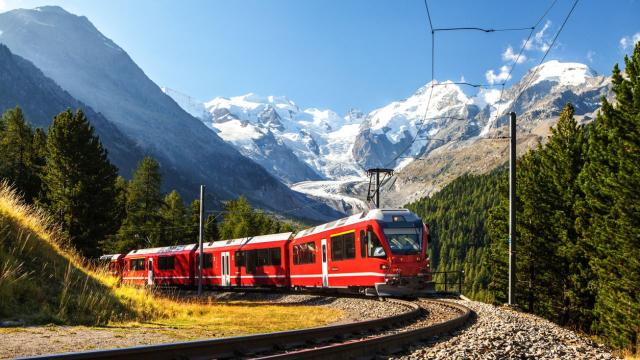While travel is certainly back in a big way, it’s also clear that folks are looking for ways to save a penny while exploring abroad. For some considering a Euro summer, this may mean considering train travel rather than flying, and in truth – that could very well add to your experience rather than take from it. Ahead, former Deutsche Bahn (German Railways) and Eurail employee Bart Giepmans discusses the benefits of using rail as a way of travelling through Europe — especially now.
Train travel through Europe: What’s the appeal?
Taking enough time [to see a destination] has always been just as important for me as leaving a small carbon footprint. I like to see the European landscape slowly passing by [on the train]. You feel the contrast with flying over thousands of kilometres, only to be catapulted into another culture.
Travelling by train can help you to find highlights you don’t otherwise miss on many routes between European capitals. Like seeing the sunset while crossing the floodplains of the Elbe River on the route between Amsterdam and Berlin. It can be mind-blowing and gives me a true feeling of covering distances.
Also, instead of airports, train stations are often impressive monumental buildings where there is a lot to see, like Paris Gare de Lyon, Marseille St-Charles or Milano Centrale. Arriving at Leipzig Hauptbahnhof and walking from the platform to the main concourse, it’s easy to feel overwhelmed by the sheer size of this impressive Art Nouveau building. It’s the largest station in Europe!
And while flying may be faster on many long routes, taking the train to many European cities can save you from waiting in lines and transiting from the airport into the city. Often, central railway stations are in the bustling heart of the city with direct access to public transport, within walking distance of hotels and other main attractions.
Spending days on the rails without rushing does something special to your travel experience. A slower pace allows you to pay closer attention to everything and everyone around you. You develop an eye for detail and a listening ear. You could find yourself unexpectedly having a conversation with an old lady on the night train from one city to another without knowing the language…
When I travel to places where I don’t know the language, I try to take a local guidebook or search online for a few basic greetings and words – it can be nice to use them on the train. Over time I’ve learned that failing is okay; it’s an opportunity to learn. Also, a smile says a lot. On some trains, you can choose between seats in a big open-plan coach or a place in smaller six-seat compartments. It’s usually easier to start conversations with foreigners in these six-seat compartments – where it can feel cosy and almost like you are travelling in your own moving living room.
Tips for getting the most out of rail travel

- On longer journeys, it may be wise to bring your own food and drinks – often, you can find a local market or food stall and get some local snacks. While many long-distance trains do have a dining car onboard, it could be closed, or the journey could unexpectedly take longer, so being on the safe side with something to munch on is always handy.
If the dining car is open, it’s very relaxing to have a meal and watch the landscapes pass by. Many onboard bistros are so inviting that you can easily start conversations with locals or fellow travellers, too. Be sure to check your train has one, though. - Take a night train now and then. Not only do you save an overnight stay, but you can experience a sunset or sunrise from the train. With a flexible Eurail Pass, you can take as many trains as you want within a day before boarding the night train.
- Have a Plan B: I believe you can never take the wrong train – there is always an interesting destination waiting. But sometimes, with rail travel, it may be good to have a backup. The journey may not go as you have initially planned, because of unexpected events or people you meet along the way. It’s always good to be prepared with an alternative – just in case. In saying that, where possible, plan less, enjoy more, cover less distance, and enjoy the experience. It is about the journey, not the destination.
- Have a draft beer or fresh coffee in the onboard restaurant and connect with other travellers (there are great fresh/cold draft beers on offer, especially, for example, on German and Czech trains).
- Try a regional train or a less popular route. The most exciting adventures can be found on secondary lines with smaller, lesser-known stations. Go to a railway hub, throw the dice and pick a platform. Take the first train leaving and see where you will end up. It’s a lot of fun, especially at big hubs like Munich, Milano or Zurich with plenty of destinations. Be mindful that some trains have compulsory reservations, always check before you board, or roll the dice again. (And ensure you prioritise your safety at all times.)
- Check out the news and magazine kiosks at the railway station
- Take a paper railway map for better planning: For me, it gives a better perspective of distances.
- Be flexible with your travel dates and times: Off-peak train travel can be great as it’s often less crowded, too.
- Don’t plan exceedingly long routes every day
- Don’t plan short connection times: Rather, add an extra hour to see the railway station or have a coffee.
- Don’t carry too much luggage with rail travel: Know what works for you. My motto is travel light – with just a (small) backpack, it’s easier to hop on and hop off trains. I save space on clothes and try to do some laundry on the road or in my hotel room. Packing cubes can be useful for organising, too. Also, pack tissues and/or some toilet paper. Unfortunately, clean toilets can be an issue in some countries, even in modern high-speed trains. (Hand sanitiser probably won’t go astray, either.)
- When travelling by night train, take longer rides: You can either enjoy dinner in the evening in the restaurant or your private cabin or wake up with fresh coffee and croissants while seeing a new landscape passing in the morning. Night trains can be a fantastic addition to your travel experience, but you should take the time to enjoy your stay on board and avoid routes that take less than eight hours.
- Always take earplugs: If you share a cabin, but also if you have your private cabin. In some trains, the walls between the Eurail cabins are very thin, and it feels like your snoring neighbour is right next to you.
- Booking tickets well in advance can give you fantastic bargains: Depending on the region you go to, there may be interesting offers for regional or urban transport (like travelling all day for only 10 Euros in some German and French regions). For more spontaneous, flexible, and unlimited train travel in 33 European countries, a Eurail Pass is a great investment.
Bart Giepmans is a train travel expert and author. A former employee of Deutsche Bahn (German Railways) and Eurail, Bart has, in more recent years, authored his own book Perron Europa by Uitgeverij Fjord and continues to consult for Eurail on all things sustainable and slow travel.

Leave a Reply
You must be logged in to post a comment.